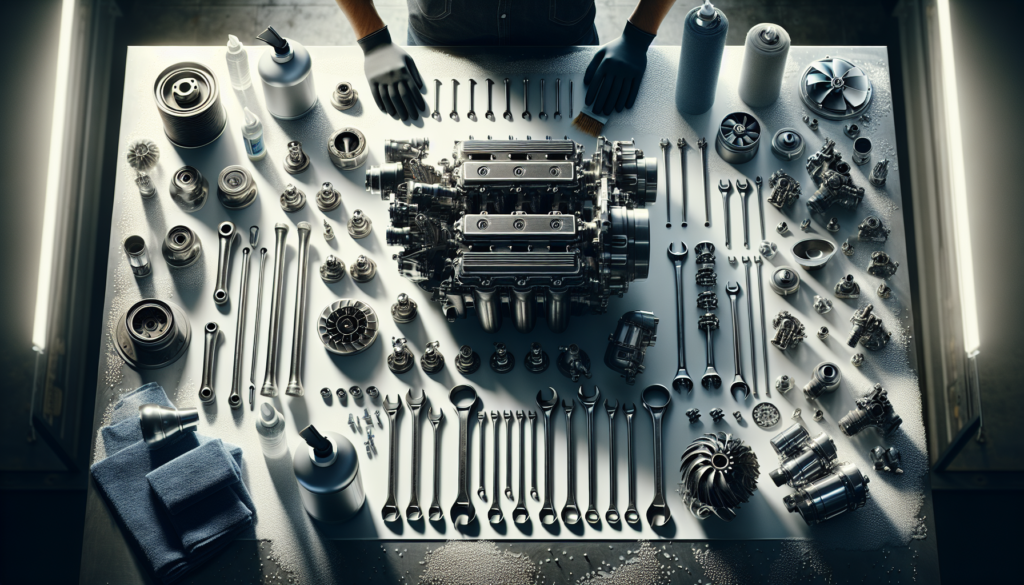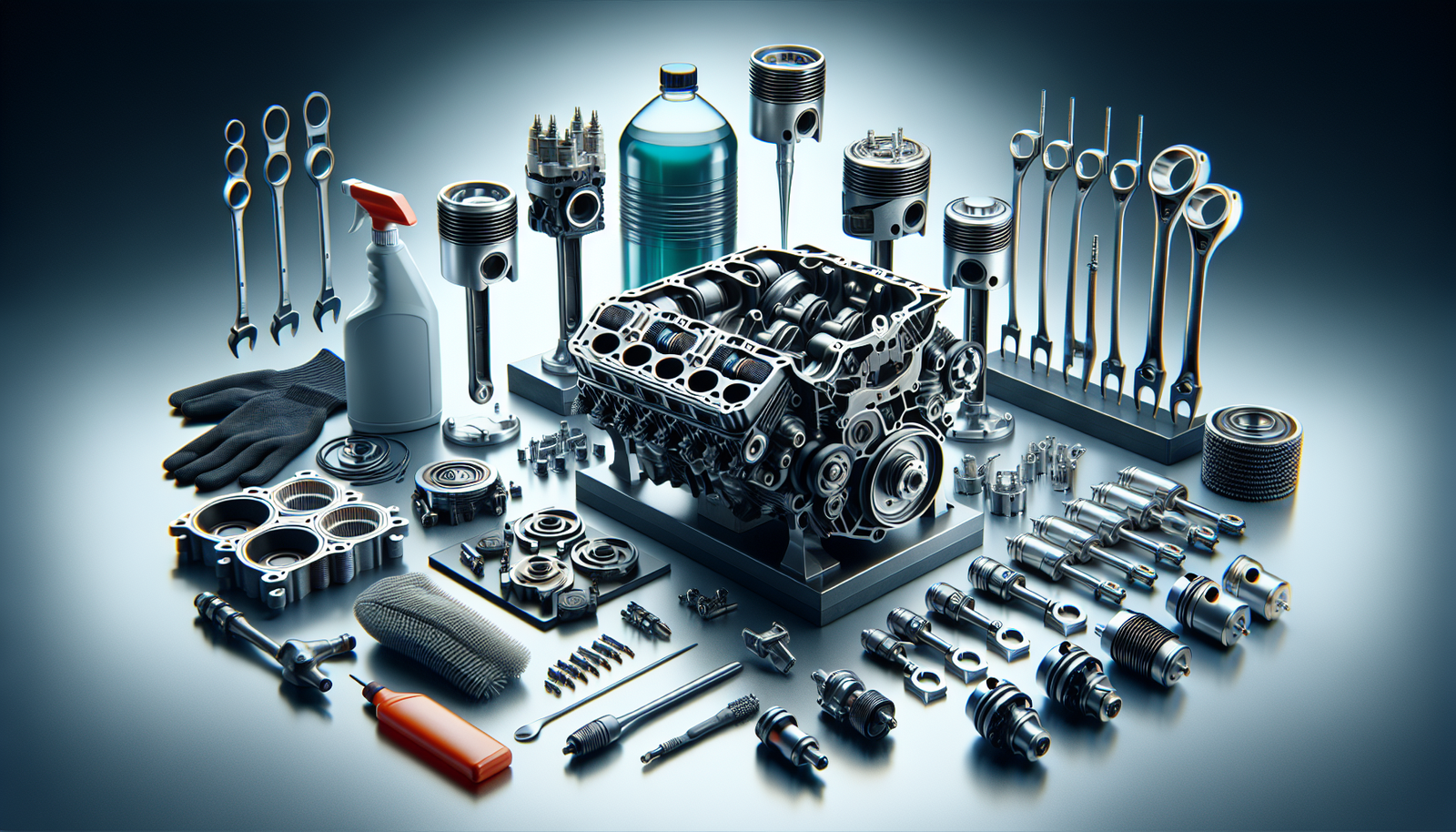Navigating through the deep, blue sea on your prized boat can be such an exhilarating experience. But just like any other form of machinery, your boat’s engine needs regular care and upkeep to keep it running smoothly. This is where knowing how to properly clean boat engine parts comes in handy. It doesn’t matter if you are a seasoned sailor or a boat beginner, the techniques and tips shared in ‘How to Properly Clean Boat Engine Parts’ will empower you to keep your boat in tip-top shape. No mechanic required!

Understanding the Importance of Regular Cleaning
Cleaning your boat regularly is not just about maintaining its appearance, it’s a vital part of boat maintenance. Cleaning your boat’s engine parts properly is particularly important. We’re talking about preserving the longevity of your treasure and also saving big on potential repair costs.
Knowing the Benefits of Routine Maintenance
Regularly cleaning your boat’s engine parts can significantly reduce wear and tear and increase its lifespan. It helps in identifying potential issues early and addressing them before they become major concerns. Regular maintenance also ensures that your boat operates at its optimal efficiency.
Recognizing the Signs of a Dirty Engine
Your boat’s engine may be dirty if it is not performing as expected. The signs may vary from excessive smoke from the exhaust, rough idling, increased fuel usage, and sputtering, among others. These signs should not be ignored as they are indicators of imminent serious concerns.
Understanding the Link Between Clean Engine Parts and Performance
A clean engine runs smoother, uses less fuel, and delivers more power compared to a dirty one. The fuel and air mixture burns more efficiently in a clean engine, resulting in better performance and less emissions. Regular cleaning not only improves the performance of your boat but also contributes to environmental conservation.
Identifying the Different Boat Engine Parts
To properly clean your boat’s engine, it is essential to understand the different parts of a boat engine. This can help ascertain what needs cleaning, and also how to go about it carefully without causing damage.
Parts of an Outboard Motor
The key components of an outboard motor include the powerhead, gearcase, propeller shaft, and propeller. These parts each play unique roles and knowing them increases your understanding of how an engine functions and how to care for it properly.
Parts of an Inboard Motor
An inboard motor’s central parts include the engine block, cylinder heads, pistons, crankshaft, and risers. Like the outboard motor, identifying these parts and their respective functions will help you approach cleaning and maintenance with knowledge and confidence.
Common Parts that Need Regular Cleaning
Typically, the carburetor, combustion chamber, cylinder heads, gear case, and propeller need regular cleaning. Paying special attention to these components will significantly contribute to your boat’s overall performance.
Gathering Essential Cleaning Materials
To get your engine clean, you’ll need some specific materials. The right solution, tools, and safety gear are essential for an effective and safe cleaning process.
Choosing Appropriate Cleaning Solutions
When it comes to cleaning solutions, opt for environmentally friendly and non-abrasive products. The cleaning solution should be capable of effectively removing grease, grime, and dirt without damaging the engine parts.
Determining Necessary Cleaning Tools
The key cleaning tools may include a soft bristle brush to clean parts without scratching, a crevice tool to reach those hard-to-reach areas, and some soft cloth for wiping down and drying components. Other useful tools may include a scraper to get rid of stubborn grime and a compressed air blower to blow out dust and debris.
Selecting Safety Gear for the Cleaning Job
Safety should not be compromised during the cleaning process. Gloves will protect your hands, safety goggles will guard your eyes, and a dust mask will prevent you from inhaling potentially harmful particles.

Preparing the Boat Engine for Cleaning
Before you start cleaning, take necessary precautions to ensure the job is done safely and correctly.
Safety Considerations Before Starting
Ensure the engine is off and cool to touch to prevent burns. Also, check your surrounding area to assure you have a clean, well-ventilated area to work.
Disconnecting Power Sources
Before you begin cleaning or disassembling parts, disconnect the battery and power sources. This is crucial to prevent electrical shocks or any form of accidental startup while working on the engine.
Assessing the Engine Condition Before Cleaning
Inspect your engine thoroughly. This step will help you notice any unexpected damages or leaks that may need to be addressed before you proceed with the cleaning.
Starting with External Cleaning Process
The external parts of your boat’s engine are constantly exposed to water, salt, and dirt, making regular cleaning essential.
Finding the Best Techniques for Surface Cleaning
The best technique for surface cleaning involves using a mild detergent and soft-bristle brush to scrub off dirt, followed by rinsing with clean water.
Removing External Grime and Dirt
Continuous exposure to marine environments can lead to the buildup of dirt and grime on the engine’s surface. Scrub these off gently using a brush, being careful not to scratch the surface or damage any parts.
Rinsing and Drying the Engine
After cleaning, rinse thoroughly with clean water taking care not to spray directly into any parts that shouldn’t get wet. Dry it fully to prevent any residual moisture that could lead to corrosion or rust.
Tackling the Internal Parts
Regular cleaning of the internal parts is essential to maintaining your engine’s overall performance.
Learning How to Disassemble Crucial Parts
Take some time to learn how to disassemble crucial parts for thorough cleaning. Make sure to keep track of where every part goes to make reassembly easier.
Taking Care While Cleaning Sensitive Parts
Some internal parts are sensitive and require special care. Make sure you understand what each part does so you don’t damage them during cleaning.
Reassembling Parts post Cleaning
Orderly reassembly of parts is crucial for the smooth running of your engine. Again, knowing where each part goes is key here.
Special Cleaning for Carburetor and Fuel Systems
The carburetor and fuel system are two of the essential parts of the boat’s engine that require regular and careful cleaning.
Understanding the Importance of a Clean Carburetor and Fuel System
A dirty carburetor leads to poor fuel efficiency and performance, while a contaminated fuel system can cause the engine to perform poorly, or even not start at all.
Assisting with Step-by-step Process
Take the time to learn proper techniques for cleaning the carburetor and fuel system. Be sure to follow each step closely and carefully.
Preventing Mishaps During the Cleaning Process
Being careful during the cleaning process can prevent mishaps. Remember to disconnect power sources and use recommended cleaning agents only.
Cleaning Electrical Components
Cleaning the electrical components of your boat can be a little tricky, but it’s necessary for the ongoing performance of your vessel.
Safely Cleaning Spark Plugs and Wiring
When cleaning spark plugs, remove them and clean the tips with a wire brush. For wiring, use a cleaning spray designed for electrical components. Never submerge wiring or plugs in water.
The Right Way for Cleaning Sensors and Switches
Wipe sensors and switches gently with a damp cloth. Be careful not to allow water or excessive moisture into these components as it could damage them.
Preventive Measures to Avoid Damaging the Electrical Parts
Avoid using abrasive materials or excessive force when cleaning electrical parts. Never use water to clean electrical components.
Post-Cleaning Maintenance Tips
Just as the cleaning process is essential, so is the care taken post-cleaning.
Ensuring All Parts are Dry Before Reattachment
Make sure all parts are thoroughly dry before reattaching them to prevent corrosion or rust.
Applying Lubricants to Prevent Rust
Use a water-displacing lubricant on all metal parts as it forms a protective coating that repels water and prevents rust and corrosion.
Checking Functionality of Parts Post Cleaning
Before you start the engine, check that all parts are properly functioning. Make sure there are no leaks, and that all parts are correctly installed and secured.
When to Seek Professional Help
While regular DIY cleaning of your boat’s engine is an essential aspect of maintenance, there may come a time when you need to seek professional help.
Identifying Complex Cleaning Tasks
If you come across a component that is difficult to disassemble or clean, it’s best to call in a professional. Complex cleaning tasks can sometimes lead to unintentional damage if not performed properly.
Understanding Situations that Need Professional Involvement
If your boat’s performance continues to decline despite regular cleaning, it may be time to seek professional help. It could indicate deeper, unseen problems that require a professional’s touch.
Locating the Best Professionals for Your Boat Maintenance
Word of mouth can often be the best way to find reputable boat mechanics in your area. You can also do online searches, read reviews, and compare services before choosing a professional.
So there you have it; understanding the importance of regular cleaning, recognizing the signs of a dirty engine, and having the knowledge to clean your boat’s engine can add years to its life and save you money on unnecessary repairs. With the appropriate cleaning materials and right techniques, you can ensure your boat performs at its best for more enjoyable seafaring adventures.

